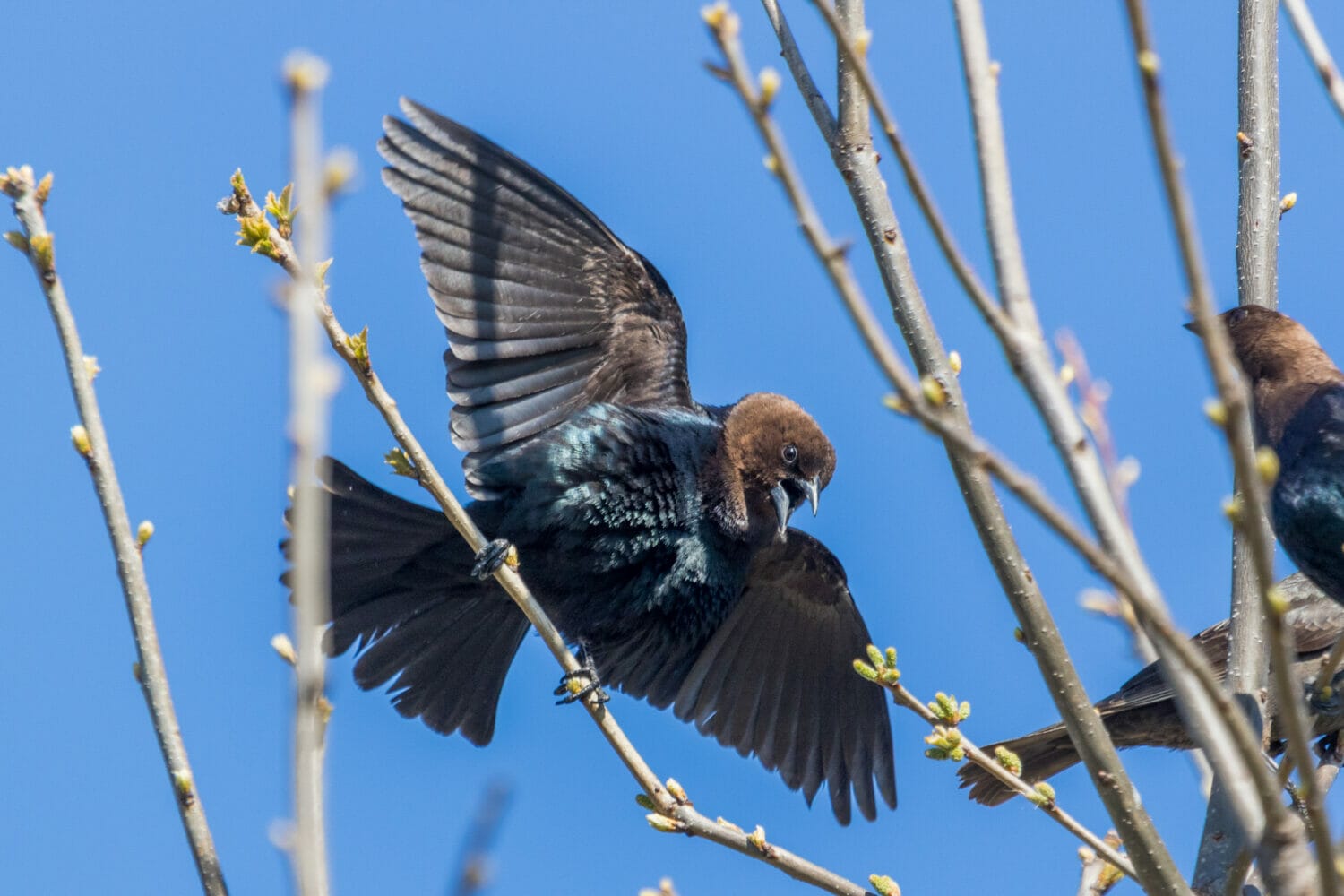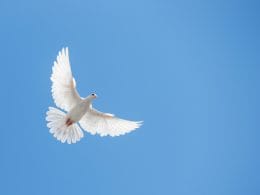In this post we will be investigating some of the black or partly-black birds in the Sunshine State of Florida.
With its unique ecosystem, Florida is home to a huge variety of birds and other animals. It has the longest coastline of any U.S. state, so a good number of birds are pale, water and sea-birds. It will be interesting to see if we can fill our Top 10 of black-colored birds.
Florida State

The Florida coastline is surrounded by the Gulf of Mexico, the Atlantic Ocean and the Straits of Florida. There is no part of the Florida peninsula that is further than 60 miles from a beach. That is a lot of water and goes some way to explaining why there is abundant exotic wildlife here. The other reason, of course, is the warm, sunny climate.
The stats on eBird are impressive, with a huge 546 bird species seen in Florida. This puts it at number 7 behind states like Alaska. It is interesting that Florida has over 6 times the number of submitted checklists than Alaska, which reflects the popularity of bird watching in Florida and the incredible number of species in Alaska!
Birds of Florida
The state bird of Florida was adopted in 1927 and is the Northern Mockingbird. This surprised me, given the sheer number of water and sea-birds present in Florida.Not only that but the mockingbird is the state bird of 4 other nearby states. The most iconic endemic bird in the state is the Florida Scrub-Jay, a vulnerable and gorgeous member of the corvid family.
Note: you can check out our extensive guide to Birds of Florida here.
The endless coastline and vastness of the Everglades attract waders and wetland specialitsts. We have tried to reflect a broader range of birds in our list of black birds visiting and resident in Florida. Here is our Top 10.
Black birds of Florida: Top 10
Eastern Kingbird (Tyrannus tyrannus)


Identification
The Eastern Kingbird is particularly attractive and rather large tyrant flycatcher with a very dark back and hood, and a white breast. Like other flycatchers, it darts in and out of its perching place to catch food. Although both sexes are alike, a slight crest can be seen at times on the male bird.
The Eastern Kingbird is quite large at 7.5 – 9.1 inches long and a wingspan of 13 – 15 inches. It weighs 1.2 – 1.9 ounces, about the same as 45 paper clips.

The Eastern Kingbird breeds throughout Florida, except on the Florida Keys. They spend winter in on the western side of South America and the Amazon. As the eBird distribution chart shows below, a few birds remain in the state during the colder months.

During summer months, the Eastern Kingbird will eat insects like grasshoppers, flies and wasps. Fruit can form part of the diet and when over-wintering, berries feature heavily.
The male bird conducts a series of ariel acrobatics, displaying a red patch on its crown, not normally seen. It is one of the few birds that will fly backwards during courtship.
Neotropic Cormorant (Nannopterum brasilianum)

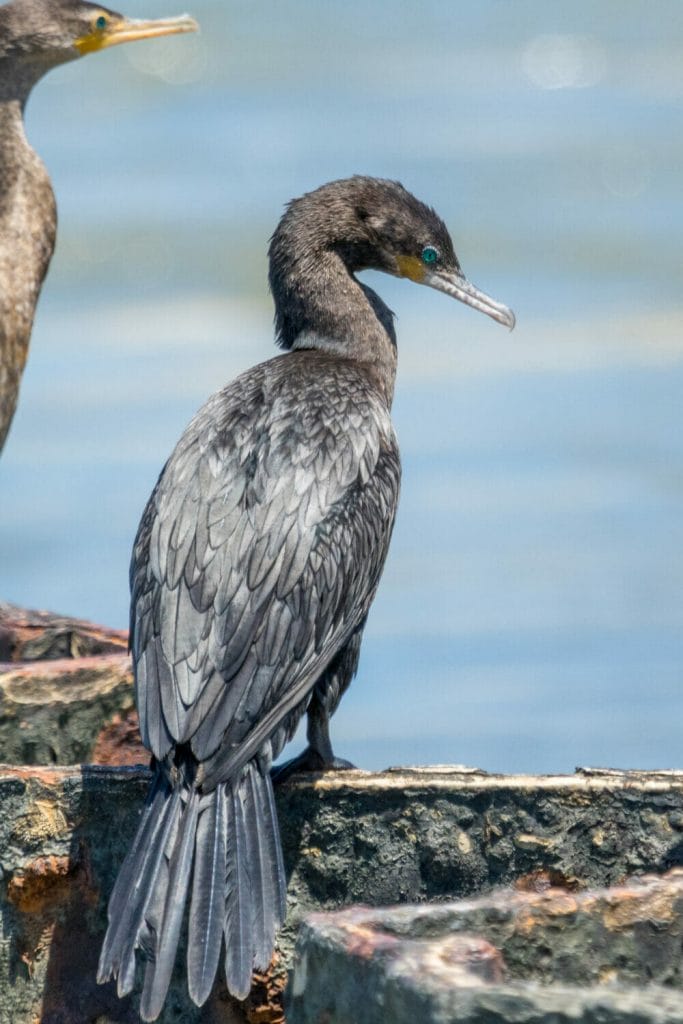
Identification
This dark bodied cormorant looks similar to many other species seen around the world. The larger bill is like that of the Double-crested Cormorant, who it is often seen with. An orange facial patch is bordered by white markings, which makes identification easier. Small, white tufts around the ears denote breeding.
The Neotropic Coromant measures 24 inches in length, with a consistent wingspan of 42 inches. It weighs in at 37.7 – 52.9 ounces, which is roughly the same as 4 – 6 standard glasses of water.

Seen mostly on the eastern side of southern Florida, the Neotropic is more common through the Gulf of Mexico. It is resident and can be seen throughout the year.

The Neotropic Cormorant dives from the surface for small fish, usually in fairly shallow, coastal waters. It can also be seen in fresh water areas like ponds and streams.
Because of their grunting call, the Neotropic Cormorant is also known as the ‘pig duck’ in parts of South America.
Brown-headed Cowbird (Molothrus ater)


The male Brown-headed Cowbird has glossy, black plumage with a dark brown head. Females are a paler brown all over. Juveniles have streaked breasts, which fades as they transition to adult.
The female bird is smaller than the male at length 6.3 – 7.9 inches and wingspan 12.6 – 15 inches. Her weight is 1.3 – 1.6 ounces
The male bird weighs in at 1.5 – 1.8 ounces and his length is 7.5 – 8.7 inches. Wingspan is 14.2 inches

The Brown-headed Cowbird is common across Florida in any areas that are not built up by humans. It is a permanent resident and can be seen all year round.

The cowbird predominately eats grass seeds and will take insects like grasshoppers and beetles when it can.
Brown-headed Cowbirds are known as ‘brood parasites’. They make no nest of their own, but lay them in over 220 other species. The female will lay her eggs in the same host species each year, up to 40 eggs per season.
Black-necked Stilt (Himantopus mexicanus)


The Black-necked Stilt is an elegant wader with long legs that are distinctly pink. The head is largely black with a white ear patch above a bright red eye. The white of the breast extends into the shoulders.
The length of both sexes of this stilt is between 13.8 and 15.3 inches with a wingspan of 28.1 – 29.7 inches. It weighs 5.3 – 6.2 ounces, about the same as 3 tennis balls.

The Black-necked Stilt is widespread across Florida, except in drier, northern areas. It is a resident and is seen usually in pairs or small groups throughout the year.

The Black-necked Stilt uses those long legs to wade into deeper water and will eat most water borne insects and larvae it comes across.
Only the Flamingo family have proportionately longer legs than that of the Stilt species.
Northern Crested Caracara (Caracara plancus)

A very unusual looking raptor of open country. It is often seen perching on posts. A black cap and back is split by a white chin, fading into speckles around the neck. It is easily identifiable by the bright orange bill tipped with gray.
The Northern Crested Caracara is a large bird, weighing 37 – 45.9 ounces, which is around the same as a liter of water. Its length is 19.3 – 22.8 inches and it has a wingspan of 48 – 49.2 inches.

The Northern Crested Caracara, as seen in the range map, can be found across the peninsula of southern Florida and as it is resident, all year round.

Simply put, the caracara will eat anything meat based. Dead or alive. Found, caught or stolen. Probably why it sits on posts along the roadside!
Whilst it might look like a hawk, the Northern Crested Caracara is actually a falcon and the only falcon to gather materials during nest making rather than reuse old nests.
Black-and-White Warber
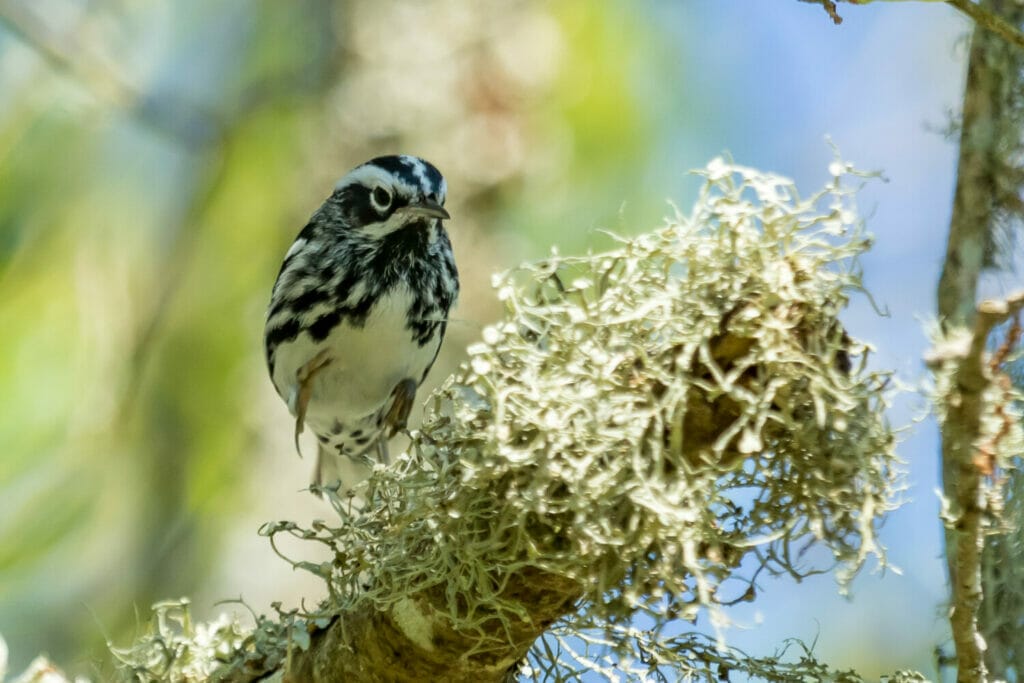

This is my favorite wood warbler and not only because it is so easy to identify. It has a gregarious nature to match those incredible black and white markings. The male is very defined, whereas the female and juveniles are paler, especially around the throat.
While the warbler looks very small, it is not much smaller than a nuthatch, at 4.3 – 5.1 inches long with a wingspan of 7.1 – 8.7 inches. It is incredibly light though, weighing in at only 0.3 – 0.5 ounces, which is smaller than one AAA battery.

This warbler is migratory, reaching Florida in early March, before moving north during the summer months.

The Black-and-White Warbler loves caterpillars. It will eat arthopods like spiders and weevils as well.
The only member of the family Mniotilta, the Black-and-White Warbler is a ‘moss-plucker’ which is reference to its habit of digging into bark and moss for food.
Great Northern Diver or Common Loon (Gavia immer)


This is a simply stunning water bird with a glossy black head extending down into stripes and spots of white. Non-breeding plumage is plainer with dark gray on top and white underneath.
It is a large member of the loon family with a wingspan of 40.9 – 51.6 inches and length of 26 – 35.8 inches. Both sexes are alike and weigh between 88.2 and 215.2 ounces, a very big range.

The Common Loon prefers the winter warmth of Florida and is best seen then. It is present all around the coast and further inland towards the top of the peninsula.

The Common Loon feeds on many fish species, often taking advantage of any kind of temporary abundance in a particular type. Chicks are also fed larvae and leeches.
Where do we start with this fascinating water bird? That it has special barbs in its mouth to keep hold of fish, or that it can fly at up to 70 mph, or that it needs up to 3/4 mile space on water to run up to flight? Or even why it has 2 names? There is so much that is unusual about the loon that it needs a post all to itself!
Black-bellied Whistling-Duck (Dendrocygna autumnalis)


Unmistakable member of the whistling-duck family with deep red breast and sharp demarcation to the black belly. It must be one of the easiest ducks to identify in flight! It also has long, bright pink legs in case you weren’t sure. The juvenile is harder to identify, with a pale brown plumage, without the black belly.
This medium sized duck has a length of 18.7 – 19.5 inches and a wingspan of 30 – 37 inches. It weighs in at 22.9 – 35.9 ounces, which is about the same as a large loaf of bread.


The main diet for this whistling-duck is plants, grasses and weeds. It will also eat molluscs at times.
Whistling-ducks used to be called ‘Tree ducks’ because that is where they would roost. In reality, only a few sub-species actually perched high up. The Black-bellied Whistling-Duck is one of them.
Black Skimmer (Rynchops niger)


This is a most unusual bird that initially looks a lot like a tern. On closer inspection, however, you can see the upper mandible is much shorter than the lower. It uses this biology in order to skim the surface of the water as it flies, scooping up small fish.
The Black Skimmer weighs in at 9.3 – 12.9 ounces, the same approximately as 2 baseballs. Its length is 15.8 – 19.7 inches and it has a wingspan of 42.9 – 45.3 inches.
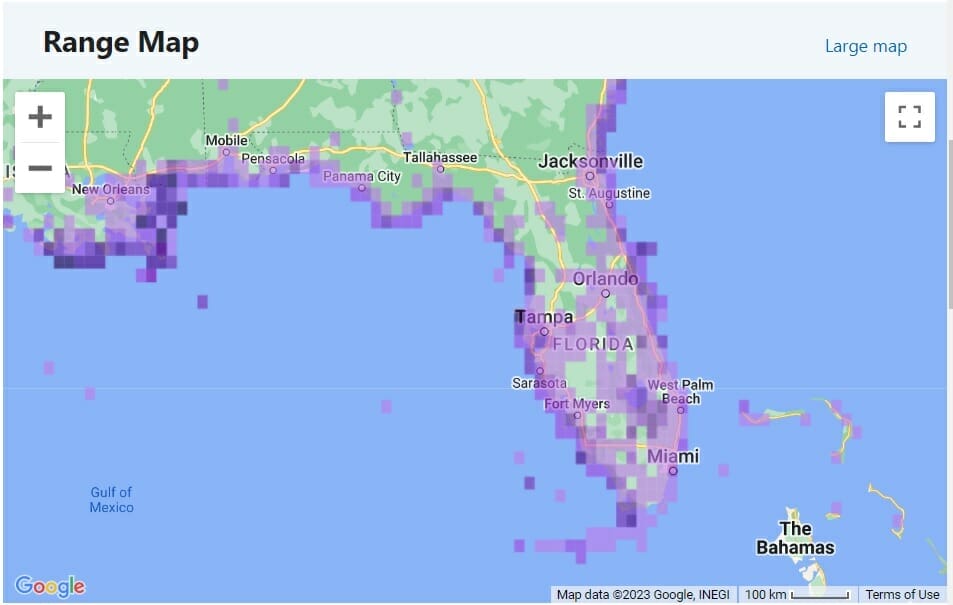
Black Skimmers are resident in Florida and can be found anywhere along the coastline. Florida is one of the few places that it can be seen inland, sometimes in large numbers.

As skimmers eat on the wing, little is known about their diet. It is thought that they will catch small fish of no more than 5 inches long that swim close to the surface of the sea.
Although you can see Black Skimmer on the beach during day time, it actually prefers feeding in low light and at night, using that incredible bill to feel its way across the water.
Black Scoter

Identification
The Black Scoter is another very attractive water bird. The male has entirely black plumage with a bright orange knob at the base of his bill. Females are brown with a pale cheek.
The Black Scoter has a length of 16.9 – 19.3 inches and wingspan of 27.6 – 28.4 inches. Its weight is between 30.4 and 38.8 ounces, roundabout the same as 6 medium-sized apples.

The Black Scoter is an uncommon sighting around the coast of Florida, more often seen in the winter months. During spring – autumn it migrates to northern breeding grounds.

The Black Scoter feeds in fresh and salt water, taking insects and molluscs respectively. They may also feed on larvae, fish eggs and seeds.
The male Black Scoter loves to sing and scoter flocks are often heard well before they are seen.
FAQ
The Boat-tailed Grackle, as well as other grackle species, are our honorable mentions. They don’t make the Top 10 but that isn’t because they aren’t special enough. I remember being chided by a birding friend for taking so many photos of them, being told ‘but they are so common’. My reply was that they are only common if you see them all the time. As a visitor to the U.S., I was thrilled by them. However, in Florida, they are just pipped by our chosen birds.
In short, no. If you think you see one, check again for those grackles!
Other black birds not included in our Top 10 are: blackbirds, woodpeckers and the anhinga. Maybe in part 2!
We hope you enjoyed our list. It was tougher than we thought to narrow it down. Let us know if you want us to go to a top 20.




